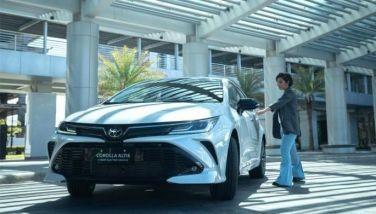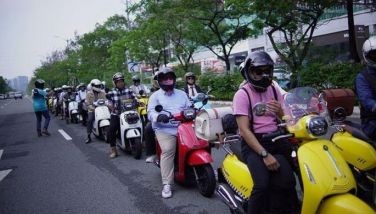Natural Gas for Transport Viable
September 8, 2004 | 12:00am
Reduce expenses on fuel oil. Use natural gas, especially for transport.
This, the country can achieve if it gives more attention to the development of its natural gas resources.
Since 1993, the government — through the Department of Science and Technology (DOST) and the Philippine Council for Industry and Energy Research and Development (PCIERD) — has been pushing for the development of natural gas as an alternative fuel source.
In 2002, after several projects that proved the viability of natural gas as an alternative fuel source were completed, PCIERD and the Department of Energy (DOE) urged the government to use natural gas in the transport sector.
This resulted in the launching of the Natural Gas Vehicle Program for Public Transport (NGVPPT) by President Gloria Macapagal-Arroyo on October 16, 2002. She also encouraged various government agencies and the private sector to use this indigenous fuel especially for public transport.
However, these activities have yet to be fully implemented because of certain market conditions and infrastructure programs that have yet to be satisfied and/or implemented.
"Natural Gas has an added advantage of being environment-friendly since it is a clean-burning alternative fossil fuel due to its low levels of sulfur oxide and nitrogen oxide emissions," stressed PCIERD through its Executive Director Graciano Yumul, Jr.
However, its promotion and commercialization will only be successful when certain conditions exist in the market. These include availability of reliable and economical technology, support from the fuel supply industry, a good price spread between clean fuel alternatives and traditional fuels, interest in promoting clean air and stricter environmental standards, and government and private sector support.
The country’s first natural gas project was implemented in 1993 when an investigative program for natural gas utilization was formed into an ASEAN regional joint cooperation program.
This was conceptualized under the management of the ASEAN Committee on Science and Technology (COST) through the initiative of the ASEAN Subcommittee on Non-conventional Energy Research (SCNCER).
The DOST, as a member of the ASEAN COST through PCIERD, developed and managed the project to optimize the use of indigenous energy sources and to improve the quality of the environment through the use of natural gas in the local transport sector.
Today, in the Southeast Asian region except in the Philippines, natural gas has become widely used and promoted as an alternative fuel source.
PCIERD pointed out that the most important consideration in developing the natural gas industry, specifically for the transport sector, is the competitiveness of compressed natural gas (CNG) as an alternative fuel in terms of market price. The study that PCIERD supported showed that CNG is actually a good substitute for diesel.
"What will stop the transport market from utilizing it (CNG) is if there is no available infrastructure to support the market. Huge investment for infrastructure development is needed," PCIERD stressed.
At the very least, the transport sector will have to wait for other markets, such as the industrial and commercial markets, to be developed. Likewise, this would entail large capital investment and it would be uneconomical for the transport sector to shoulder the cost alone.
It is for this reason that the DOE and other industry stakeholders are preparing a development plan for a downstream natural gas industry that will involve a 100-kilometer gas pipeline from Batangas to Manila and, possibly, a subsea pipeline from Sabah in Malaysia to the Philippines.
The Malampaya gas reserve in Palaway also serves as a source for natural gas, with gas reserve deposits of 3.4 trillion cubic feet of natural gas. Its development is expected to provide 3,000 megawatts of electricity for 20 years.
PCIERD reported that for the meantime, as the natural gas pipeline is not yet in place, a mother-daughter fueling system will be put up in Batangas and in Metro Manila to initially propel the use of CNG for 100 public utility buses.
On the other hand, President Arroyo has directed the DOST to promote and develop locally-manufactured CNG conversion kits and/or components.
Also through PCIERD, the localization of CNG components is being conducted. In fact, these components will be studied by the DOST’s Metals Industry Research and Development Center (MIRDC) for reverse engineering.
In the PCIERD-monitored project on natural gas, an Isuzu Highlander 4JA1 diesel engine was converted to natural gas. The vehicle was then tested by the Energy Research and Development Center (ERDC) of the Philippine National Oil Corp. (PNOC).
A small CNG refueling station was also installed at the PNOC’s gas power plant in Echague, Isabela for the extraction of the gas to be used for the vehicle’s engine bench testing. The vehicle was also subjected to road tests in Isabela, Cagayan, Ifugao and the Mt. Province. All in all, it traveled a total of 400 kilometers.
A 15,000-km test-run was also conducted to get more data and to verify the engine’s performance and efficiency versus that of a diesel engine of similar size. The test runs proved the efficiency and environment-friendliness of natural gas.
PCIERD noted that tail pipe emissions from the said vehicle had significantly less carbon monoxide, nitrogen oxide sulfur dioxide and other particulate matter emissions that conventional fuels. Natural gas also has a higher octane rating than regular unleaded petroleum, which results in up to 20 percent increased engine efficiency.
This, the country can achieve if it gives more attention to the development of its natural gas resources.
Since 1993, the government — through the Department of Science and Technology (DOST) and the Philippine Council for Industry and Energy Research and Development (PCIERD) — has been pushing for the development of natural gas as an alternative fuel source.
In 2002, after several projects that proved the viability of natural gas as an alternative fuel source were completed, PCIERD and the Department of Energy (DOE) urged the government to use natural gas in the transport sector.
This resulted in the launching of the Natural Gas Vehicle Program for Public Transport (NGVPPT) by President Gloria Macapagal-Arroyo on October 16, 2002. She also encouraged various government agencies and the private sector to use this indigenous fuel especially for public transport.
However, these activities have yet to be fully implemented because of certain market conditions and infrastructure programs that have yet to be satisfied and/or implemented.
"Natural Gas has an added advantage of being environment-friendly since it is a clean-burning alternative fossil fuel due to its low levels of sulfur oxide and nitrogen oxide emissions," stressed PCIERD through its Executive Director Graciano Yumul, Jr.
However, its promotion and commercialization will only be successful when certain conditions exist in the market. These include availability of reliable and economical technology, support from the fuel supply industry, a good price spread between clean fuel alternatives and traditional fuels, interest in promoting clean air and stricter environmental standards, and government and private sector support.
The country’s first natural gas project was implemented in 1993 when an investigative program for natural gas utilization was formed into an ASEAN regional joint cooperation program.
This was conceptualized under the management of the ASEAN Committee on Science and Technology (COST) through the initiative of the ASEAN Subcommittee on Non-conventional Energy Research (SCNCER).
The DOST, as a member of the ASEAN COST through PCIERD, developed and managed the project to optimize the use of indigenous energy sources and to improve the quality of the environment through the use of natural gas in the local transport sector.
Today, in the Southeast Asian region except in the Philippines, natural gas has become widely used and promoted as an alternative fuel source.
PCIERD pointed out that the most important consideration in developing the natural gas industry, specifically for the transport sector, is the competitiveness of compressed natural gas (CNG) as an alternative fuel in terms of market price. The study that PCIERD supported showed that CNG is actually a good substitute for diesel.
"What will stop the transport market from utilizing it (CNG) is if there is no available infrastructure to support the market. Huge investment for infrastructure development is needed," PCIERD stressed.
At the very least, the transport sector will have to wait for other markets, such as the industrial and commercial markets, to be developed. Likewise, this would entail large capital investment and it would be uneconomical for the transport sector to shoulder the cost alone.
It is for this reason that the DOE and other industry stakeholders are preparing a development plan for a downstream natural gas industry that will involve a 100-kilometer gas pipeline from Batangas to Manila and, possibly, a subsea pipeline from Sabah in Malaysia to the Philippines.
The Malampaya gas reserve in Palaway also serves as a source for natural gas, with gas reserve deposits of 3.4 trillion cubic feet of natural gas. Its development is expected to provide 3,000 megawatts of electricity for 20 years.
PCIERD reported that for the meantime, as the natural gas pipeline is not yet in place, a mother-daughter fueling system will be put up in Batangas and in Metro Manila to initially propel the use of CNG for 100 public utility buses.
On the other hand, President Arroyo has directed the DOST to promote and develop locally-manufactured CNG conversion kits and/or components.
Also through PCIERD, the localization of CNG components is being conducted. In fact, these components will be studied by the DOST’s Metals Industry Research and Development Center (MIRDC) for reverse engineering.
In the PCIERD-monitored project on natural gas, an Isuzu Highlander 4JA1 diesel engine was converted to natural gas. The vehicle was then tested by the Energy Research and Development Center (ERDC) of the Philippine National Oil Corp. (PNOC).
A small CNG refueling station was also installed at the PNOC’s gas power plant in Echague, Isabela for the extraction of the gas to be used for the vehicle’s engine bench testing. The vehicle was also subjected to road tests in Isabela, Cagayan, Ifugao and the Mt. Province. All in all, it traveled a total of 400 kilometers.
A 15,000-km test-run was also conducted to get more data and to verify the engine’s performance and efficiency versus that of a diesel engine of similar size. The test runs proved the efficiency and environment-friendliness of natural gas.
PCIERD noted that tail pipe emissions from the said vehicle had significantly less carbon monoxide, nitrogen oxide sulfur dioxide and other particulate matter emissions that conventional fuels. Natural gas also has a higher octane rating than regular unleaded petroleum, which results in up to 20 percent increased engine efficiency.
BrandSpace Articles
<
>
- Latest
Latest
Latest
September 30, 2024 - 4:26pm
By EC Toledo | September 30, 2024 - 4:26pm
September 26, 2024 - 3:30pm
September 26, 2024 - 3:30pm
August 16, 2024 - 11:00am
By Euden Valdez | August 16, 2024 - 11:00am
Recommended






























